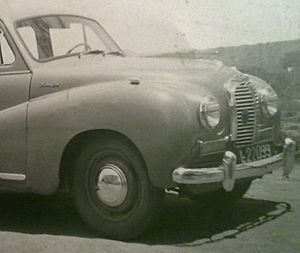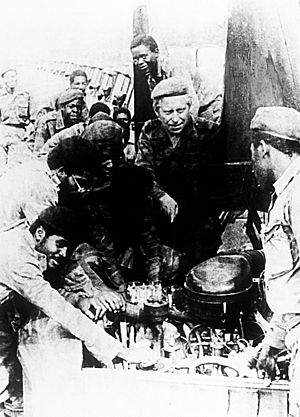History of Angola facts for kids
Angola was first home to San hunter-gatherer groups. Later, powerful Bantu kingdoms like Kongo and Ndongo grew in the north. In the 1400s, Portuguese explorers arrived and began trading. They built a settlement in Luanda in the 1500s. Portugal took control of more land, ruling Angola as a colony from 1655. In 1951, Angola became an overseas province of Portugal.
Angola fought for its freedom in the Angolan War of Independence. This war ended in 1974 after a military uprising in Portugal. Angola finally became independent in 1975 through the Alvor Agreement. However, after gaining independence, Angola faced a long and difficult civil war that lasted until 2002.
Contents
Early History of Angola
The land that is now Angola has been lived in for a very long time. Signs of ancient people have been found in Luanda, Congo, and the Namibe desert.
The first known people to live here were the San people. Around 500 AD, the Bantu began moving into the area from the north. They brought new skills like working with metal, making pottery, and farming. When they arrived, they met the San and other groups. It took many centuries for the Bantu to settle and form different ethnic groups.
The Kingdom of Kongo
The first big kingdom in this area was the Kingdom of Kongo. It started in the 1200s. This kingdom was huge, stretching from Gabon in the north to the river Kwanza in the south. It went from the Atlantic Ocean in the west to the river Cuango in the east.
The Kongo Kingdom became rich mainly through farming. Important leaders called Mani ruled different parts of the kingdom. They answered only to the powerful King of the Kongo. The capital city, Mbanza Congo, was very large. In the 1500s, it had over 50,000 people.
The kingdom had six provinces and included smaller kingdoms, like Ndongo to the south. Trade was very important, based on good farming and growing mining.
Portuguese Arrival
In 1482, Portuguese ships led by Diogo Cão reached the Kongo. He explored the coast of what is now Angola in 1484. More expeditions followed, and Portugal and the Kongo Kingdom soon became close. The Portuguese brought firearms and new technologies. They also brought a new religion, Christianity. In return, the King of the Kongo offered many slaves, ivory, and minerals.
Angola Becomes a Portuguese Colony
The Portuguese colony of Angola officially began in 1575. This was when Paulo Dias de Novais arrived with Portuguese families and soldiers. The main city, Luanda, became a city in 1605.
The King of the Kongo soon became Christian. He adopted a similar way of ruling as the Europeans. He even became well-known in Europe and received letters from the Pope.
Queen Jinga's Resistance
South of the Kongo Kingdom, near the Kwanza river, were other important states. The most important was the Kingdom of Ndongo. Its rulers were called ngolas. When the Portuguese arrived, Ngola Kiluange was in charge. He formed alliances with nearby states to resist the Portuguese for many years. But he was eventually captured and killed in Luanda.
Years later, the Ndongo kingdom became strong again under Queen Jinga Mbandi (Queen Jinga). She was a smart leader who made agreements to keep the Portuguese in check. In 1635, she formed a large alliance of states. With this strong group, she forced the Portuguese to retreat.
Dutch and Portuguese Struggles
Meanwhile, Portugal lost its king, and Spain took control of the Portuguese monarchy. Portugal's overseas lands became less important. The Dutch took advantage of this and captured Luanda in 1641. Queen Jinga joined forces with the Dutch, making her alliance even stronger. The Portuguese were pushed back to Massangano, where they built strong defenses.
Slaves from Angola were very important for the Portuguese colony of Brazil. But the fighting stopped this trade. When Portugal became independent again, a large force from Brazil recaptured Luanda in 1648. This brought many Portuguese back. Queen Jinga's alliance then fell apart. Without their Dutch allies and their firearms, the local forces lost hope.
Queen Jinga died in 1663. Later, the King of the Congo tried to take the island of Luanda but was defeated. The Kingdom of Ndongo officially became part of the Portuguese Crown in 1671.
Trade and Control
Trade was mostly with the Portuguese colony of Brazil. Many Brazilian ships came to the ports of Luanda and Benguela. It was strange because Angola, a Portuguese colony, was almost like a colony of Brazil, which was also a Portuguese colony! Brazilian Jesuits also had a strong influence on religion and education.
The slave trade was officially ended in 1836. In 1844, Angola's ports were opened to foreign ships. This made it easier for slave smuggling to continue to the United States and Brazil. By 1850, Luanda was one of Portugal's largest cities outside of Portugal. It exported many products like palm oil, wax, timber, ivory, cotton, and coffee. Most of these goods were produced by forced labor.
The Berlin Conference in the late 1800s made Portugal actually take control of all the lands it claimed. The area of Cabinda (province) in the north was also given to Portugal in 1885. Portugal slowly began to establish control in the interior of Angola. Angola, as we know it today, was not fully controlled by Portugal until the 1920s.
The colony's economy was based on agriculture and exporting raw materials. Trading rubber and ivory, along with taxes, brought a lot of money to Portugal.
Path to Independence
In 1951, Angola became an "Overseas Province" of Portugal. However, Portuguese rule was still very unfair. It was marked by racism, forced labor, and a lack of development. By 1960, after 400 years, there was not a single university in Angola.
Because of this lack of education and rights, political groups started forming in the 1950s. They demanded human rights and independence. But Portugal refused to give up control. This led to armed conflict in 1961. This war became known as the Colonial War.
The main groups fighting for independence were:
- The MPLA (Popular Movement for the Liberation of Angola), started in 1956.
- The FNLA (National Front for the Liberation of Angola), which appeared in 1961.
- UNITA (National Union for the Total Independence of Angola), founded in 1966.
After many years of fighting, Angola gained independence on November 11, 1975. This happened after a military takeover in Portugal in 1974. Portugal's new leaders decided to grant independence to their former colonies.
Angolan Civil War
After independence, Angola quickly fell into a civil war. The three main nationalist groups, MPLA, UNITA, and FNLA, could not agree on how to share power. The MPLA took control of the capital, Luanda.
Other countries got involved. The United States, Zaïre, and South Africa supported the FNLA and UNITA. They wanted to take Luanda before independence was declared. In response, Cuba sent troops to help the MPLA.
With Cuba's help, the MPLA held Luanda. They declared independence as the Angolan People's Republic on November 11, 1975. Agostinho Neto became the first president. The FNLA and UNITA tried to form their own republics, but these did not last long. By early 1976, the MPLA and Cuban forces had largely defeated the FNLA, Zairian, and South African forces.
The civil war continued for many years. The MPLA government was recognized by most countries. UNITA, led by Jonas Savimbi, received secret support from the U.S. and other nations. They fought from the southeast of the country. The MPLA government was supported by the USSR and other communist countries. South Africa also continued to support UNITA.
In 1987, the MPLA army, with Soviet help, tried to defeat UNITA. But they faced many problems. Again, the Cubans stepped in. They stopped UNITA and South African advances. This led to the Battle of Cuito Cuanavale, one of the largest battles in African history.
Peace Efforts and Continued Conflict
Negotiations for peace began in 1987. Angola, Cuba, and South Africa signed the Tripartite Accord in 1988. This agreement linked the withdrawal of Cuban troops from Angola to South African soldiers leaving Angola and Namibia.
The Bicesse Accord in 1991 set up a plan for democratic elections in Angola. The MPLA won the first round of votes. However, UNITA leader Jonas Savimbi rejected the results and returned to war. In October 1992, thousands of UNITA and FNLA supporters were killed in Luanda.
A second peace agreement, the Lusaka Protocol, was signed in 1994. This agreement aimed to bring former UNITA fighters into the government and army. But fighting started again in 1995. A national unity government was formed in 1997. However, serious fighting resumed in late 1998 when Savimbi started the war again. He claimed the MPLA was not keeping its promises.
The Angolan military launched a big attack in 1999. They destroyed UNITA's main fighting power and recaptured cities. Savimbi then said UNITA would go back to guerrilla warfare. Much of the country remained in chaos.
The long civil war made hundreds of thousands of people homeless. Up to 1 million lives may have been lost. The war finally ended when Jonas Savimbi was killed in 2002.
Angola After the War
After the civil war ended in 2002, Angola began to rebuild. The government stopped all military operations. UNITA and the MPLA military leaders met and agreed to a ceasefire. They signed a Memorandum of Understanding on April 4, 2002.
In August 2002, UNITA officially became a political party. It also disbanded its armed forces. The United Nations replaced its military mission in Angola with a larger, non-military political presence.
The civil war left many problems. Four million people, about a third of Angola's population, were displaced from their homes. The government worked to help these people return. Militant groups had also placed about 15 million landmines. Charities like The HALO Trust began clearing these dangerous mines.
The war also involved many child soldiers. Human Rights Watch estimated that UNITA used over 86,000 child soldiers, and the government used over 3,000. Efforts were made to help these children.
In 2004, a film called The Hero was made about life in Angola after the civil war. It showed the lives of ordinary Angolans. The film won a major award at the Sundance Film Festival.
José Eduardo dos Santos was President of Angola for 38 years. In 2017, he stepped down peacefully. João Lourenço, his chosen successor, became the new president. President Lourenço started a campaign against corruption from the previous era. For example, in 2017, Isabel dos Santos, the former president's daughter, was removed from her job as head of the state oil company Sonangol. In 2020, José Filomeno dos Santos, the former president's son, was sentenced to jail for fraud.
In July 2022, former President José Eduardo dos Santos died in Spain. In August 2022, the ruling party, MPLA, won another election. President João Lourenço began his second five-year term. This election was the closest in Angola's history.
Images for kids
See also
 In Spanish: Historia de Angola para niños
In Spanish: Historia de Angola para niños
- History of Africa
- History of Southern Africa
- List of presidents of Angola
- Politics of Angola
- Portuguese West Africa
- Slavery in Angola
- Cities:
- Arquivo Histórico Nacional (Angola) (national archives)





